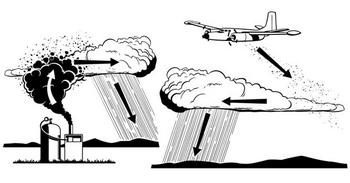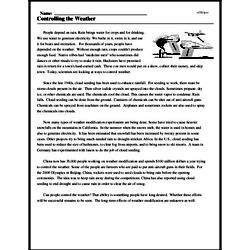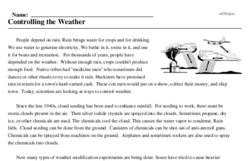Controlling the Weather
People depend on rain. Rain brings water for crops and for drinking. We use water to generate electricity. We bathe in it, swim in it, and use it for boats and recreation. For thousands of years, people have depended on the weather. Without enough rain, crops couldn't produce enough food. Native tribes had "medicine men" who sometimes did dances or other rituals to try to make it rain. Hucksters have promised rain in return for a town's hard-earned cash. These con men would put on a show, collect their money, and skip town. Today, scientists are looking at ways to control weather.
Since the late 1940s, cloud seeding has been used to enhance rainfall. For seeding to work, there must be storm clouds present in the air. Then silver iodide crystals are sprayed into the clouds. Sometimes propane, dry ice, or other chemicals are used. The chemicals cool the cloud. This causes the water vapor to condense. Rain falls. Cloud seeding can be done from the ground. Canisters of chemicals can be shot out of anti-aircraft guns. Chemicals can be sprayed from machines on the ground. Airplanes and sometimes rockets are also used to spray the chemicals into clouds.
Now many types of weather modification experiments are being done. Some have tried to cause heavier snowfalls on the mountains in California. In the summer when the snows melt, the water is used in homes and also to generate electricity. It has been estimated that snowfall has been increased by twenty percent in some cases. Other projects try to bring much-needed rain to drought-stricken Africa. In the U.S., cloud seeding has been used to reduce the size of hailstones, to clear fog from airports, and to bring snow to ski resorts. A team in Germany has experimented with lasers to do the job of cloud seeding.




